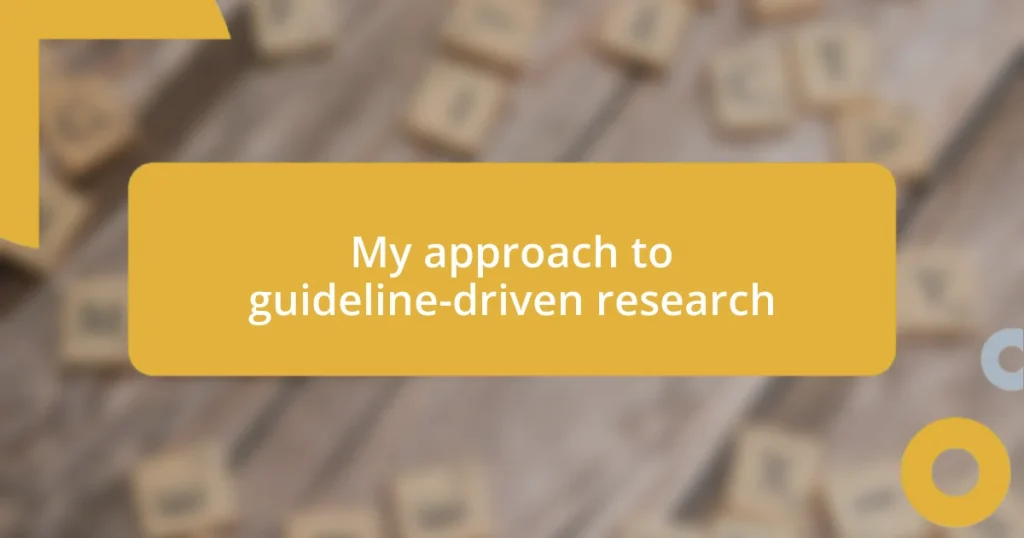Key takeaways:
- Guidelines enhance research credibility and consistency, facilitating better communication and ethical standards among researchers.
- Identifying reliable guidelines involves checking authorship, evidence base, and regular updates to ensure quality and relevance.
- Future trends include the use of technology for adherence monitoring, a focus on patient-centered guidelines, and the need for standardized training programs across institutions.
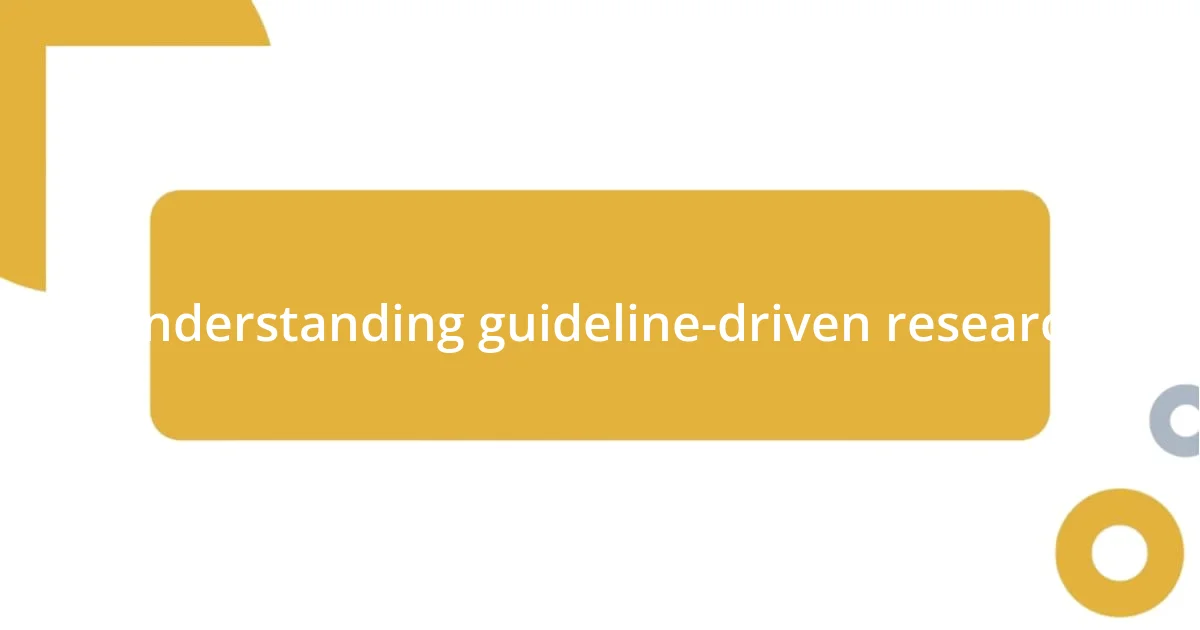
Understanding guideline-driven research
Guideline-driven research is essentially about following a structured roadmap that directs the research process. I remember the first time I navigated through a complex guideline; it felt daunting, but as I began to understand the framework, it transformed my approach to research. Isn’t it fascinating how these guidelines help streamline decisions and foster consistency, making research more reliable?
As I delved deeper into this topic, I found that guidelines can vary widely depending on the field. For example, medical research often relies on clinical practice guidelines to ensure that treatments are evidence-based and effective. This specificity not only enhances the quality of research outcomes but also makes me wonder: how would our findings differ if we didn’t have such robust guidelines in place?
Another point that strikes me is how engaging with guidelines encourages thoughtful analysis and critical thinking. I often find myself reflecting on the rationale behind each guideline, asking why certain methods are emphasized while others are overlooked. This level of introspection not only enriches my research experience but also strengthens my ability to convey ideas clearly and effectively. Wouldn’t you agree that this thoughtful dedication enhances the overall impact of our work?
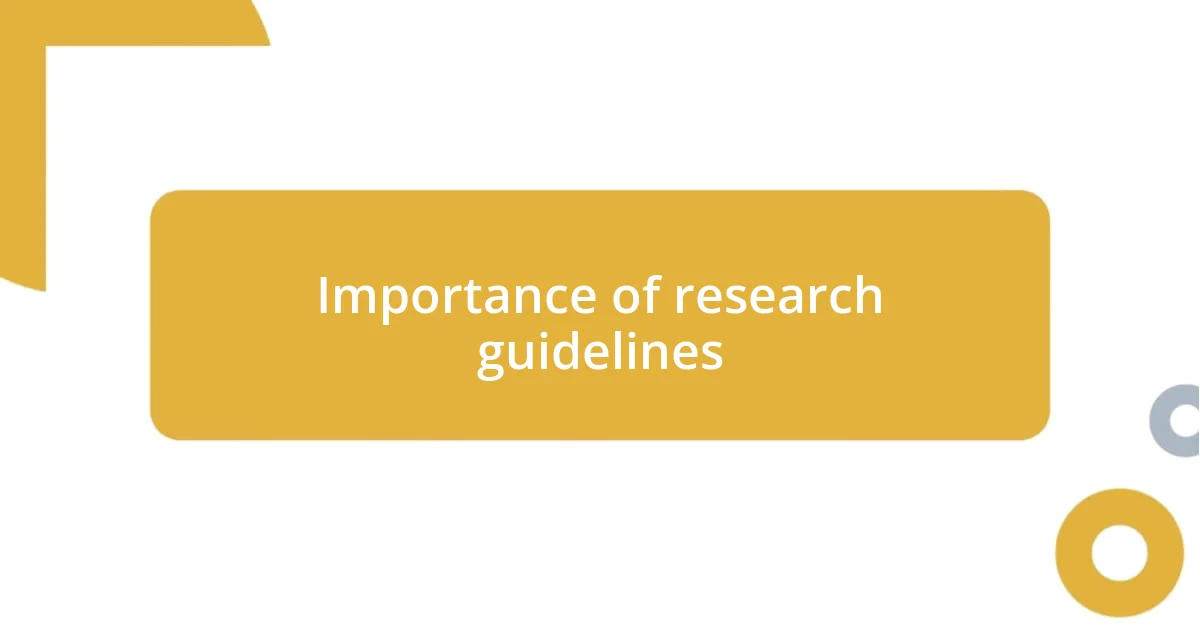
Importance of research guidelines
The importance of research guidelines cannot be overstated. They serve as the backbone of rigorous inquiry, ensuring that responses to research questions are credible and systematic. I recall a project where I overlooked certain established guidelines, resulting in a muddled study with inconsistent results. It was a learning experience that highlighted how following these frameworks can save time and enhance the integrity of our findings.
Moreover, research guidelines facilitate communication among scholars. When everyone adheres to common protocols, it creates a shared language for discussing methodologies and results. I once participated in a collaborative project where we all adhered to standardized guidelines; the synergy was palpable. We could compare our findings more seamlessly and engage in more meaningful discussions. Wouldn’t you agree that this uniformity cultivates a more productive research environment?
Finally, guidelines play a crucial role in upholding ethical standards. They remind us to think critically about the implications of our research and prioritize the welfare of participants. I’ve had to confront ethical considerations in my work, and the guidelines provided much-needed clarity during those challenging discussions. It’s moments like these that reinforce my commitment to ethical standards and remind me of the greater responsibility we have as researchers.
| Aspect | Importance |
|---|---|
| Credibility | Ensures systematic and credible results |
| Communication | Facilitates shared understanding among researchers |
| Ethics | Upholds ethical standards in the research process |
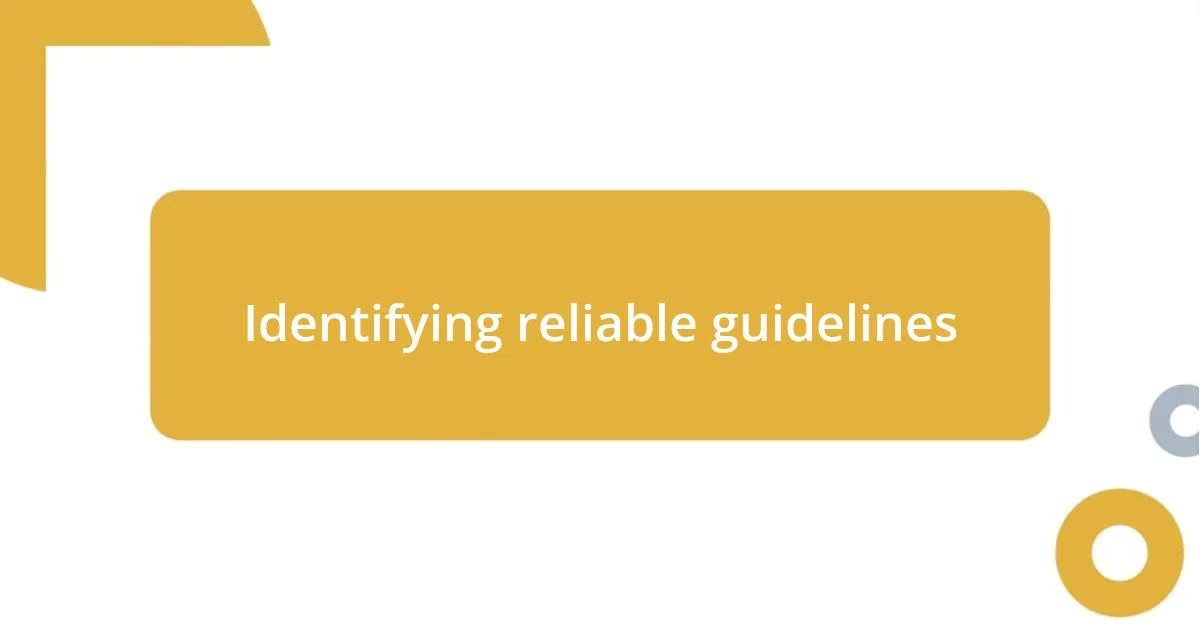
Identifying reliable guidelines
Identifying reliable guidelines can sometimes feel overwhelming, but I’ve learned a few key strategies over the years. First, I scrutinize the source of the guidelines. Are they backed by reputable organizations or institutions? I’ve encountered guidelines that seemed promising at first glance, but a quick check revealed a lack of validation. Trustworthy guidelines often come from recognized bodies like the World Health Organization or professional societies related to the field.
A few critical factors help distinguish reliable guidelines from the rest:
- Authorship: Look for guidelines authored by experts or organizations with proven credentials in the area.
- Evidence Base: Ensure that the guidelines are rooted in solid evidence, such as systematic reviews or meta-analyses.
- Revisability: Reliable guidelines are regularly updated to reflect new research and evolving practices.
I remember working on a project where we initially used a poorly-conceived guideline. The research was unfocused, and the results were baffling. After some pushback and a thorough reassessment, switching to a more established guideline made all the difference. It was like clearing up a foggy picture; suddenly, our findings were sharp, coherent, and applicable. This experience underscored the importance of identifying solid guidelines that bolster the validity of our research efforts.
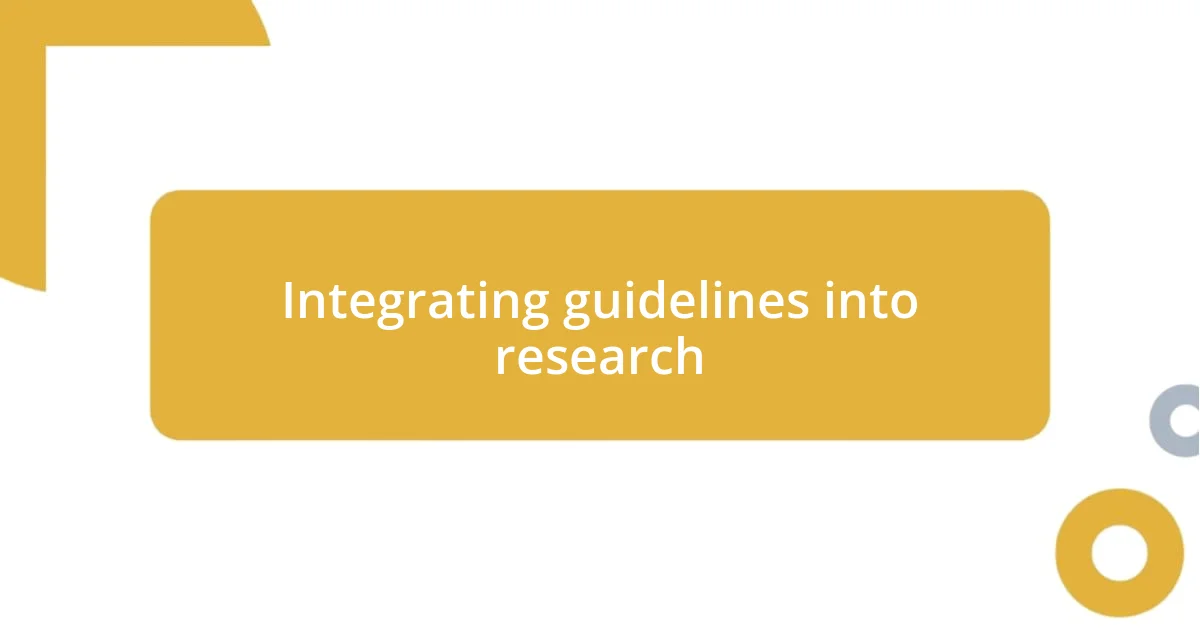
Integrating guidelines into research
Integrating guidelines into research is a crucial step that I’ve come to appreciate over time. Initially, I viewed guidelines as just another requirement to check off. However, during a project focused on community health, I made a conscious effort to embed guidelines throughout each phase. It transformed my approach entirely. I felt more confident in my decisions and noticed that the results aligned more closely with my objectives.
As I dove deeper into data analysis, I realized that integrating guidelines helped streamline processes and maintain consistency, especially in data collection. I remember a moment when a co-researcher pointed out an inconsistency in our methodology. At first, I felt defensive, but then I recognized that this feedback, rooted in our adherence to guidelines, was essential for upholding the quality of our research. Aren’t those moments of clarity where we learn the most?
Moreover, the integration of guidelines has a profound impact on collaboration. I once participated in a multi-center study where each team followed different protocols. The lack of consistent guidelines led to confusion and redundant effort. It made me wonder: how much more could we achieve if we all embraced a unified approach? The answer was clear after we aligned our methods. Our teamwork flourished, and the outcomes were not only more coherent but also more impactful.
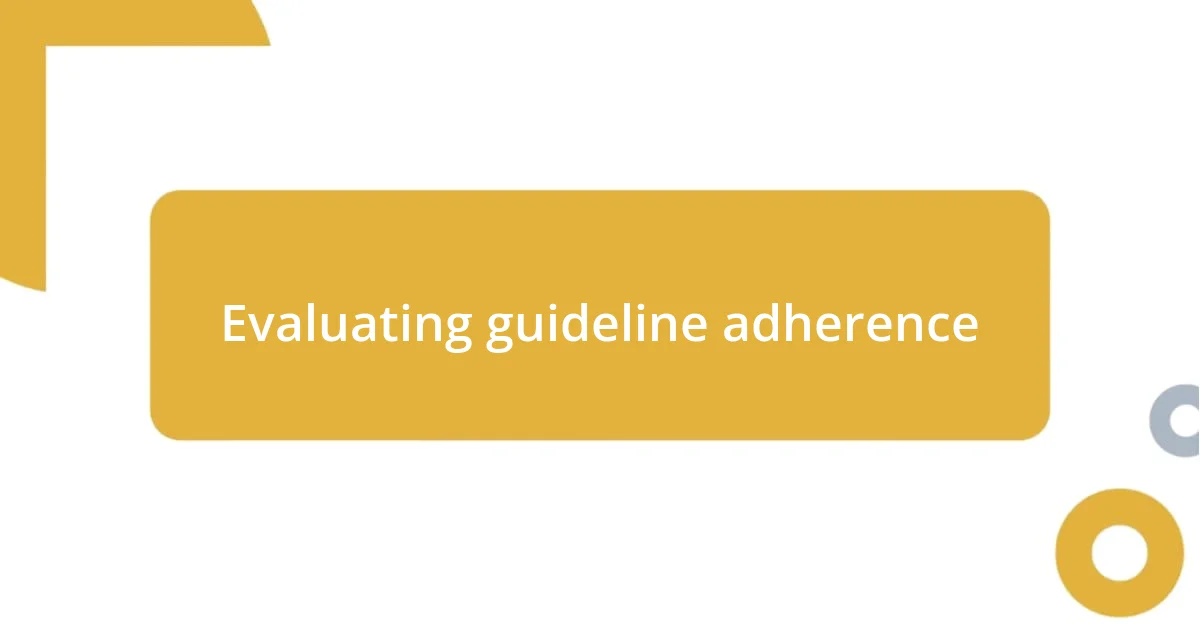
Evaluating guideline adherence
When evaluating guideline adherence, I often reflect on how adherence can dramatically influence the outcomes of research. I remember working on a clinical trial where not everyone followed the established protocols closely. The inconsistencies led to varied results across participating sites, leaving us scratching our heads when it came time to analyze the data. It made me realize how essential it is to not only follow guidelines but to actively monitor adherence; it’s the compass that keeps our research on track.
One practical method I’ve embraced is regular check-ins during the study phase. These checkpoints help ensure that the entire team is aligned and adhering to the guidelines. I recall a pivotal meeting where we reviewed our progress and discovered minor deviations from the guidelines. Instead of viewing it as a setback, I felt a surge of relief—identifying these issues early allowed us to pivot and remedy them before they snowballed. Isn’t it fascinating how a seemingly small oversight can ripple through the entire research process?
In my experience, feedback from both colleagues and external reviewers plays a vital role in evaluating adherence, too. I’ve learned the value of fostering an environment where team members feel comfortable discussing compliance, prompting meaningful conversations. For instance, during a recent peer-review session, a reviewer pointed out areas where we could improve our guideline adherence. Rather than seeing their input as criticism, I embraced it as an opportunity for growth. That kind of openness not only enhances our work but builds a culture that values integrity in research.
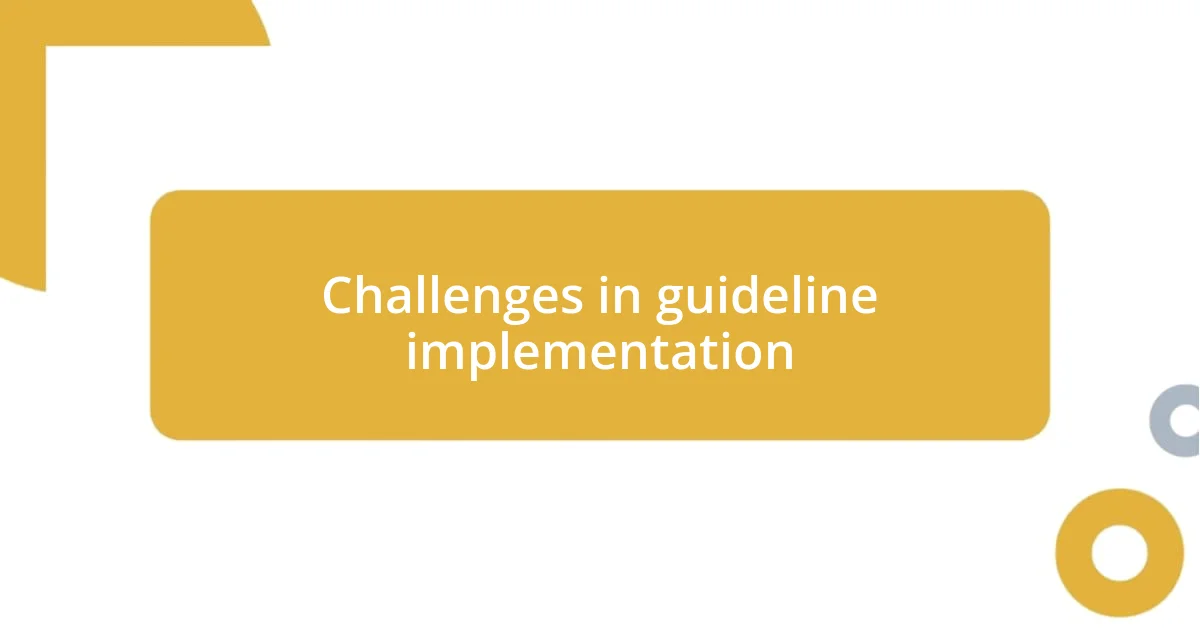
Challenges in guideline implementation
Implementing guidelines can often feel like navigating a maze, and I’ve faced my fair share of challenges along the way. One significant hurdle I’ve encountered is the sheer resistance to change among team members. For instance, during a project where we were tasked with adopting new clinical guidelines, I noticed some colleagues were reluctant to modify their established routines. This led to friction during our meetings, with questions swirling around the necessity of these new practices. Reflecting on that experience, I learned that investing time in open discussions about the ‘why’ behind guidelines can ease those fears and foster a culture of acceptance.
Another issue I’ve faced is the lack of resources for proper training on these guidelines. In one research endeavor, I found myself struggling to implement a complex set of guidelines due to limited access to relevant training materials. It was frustrating, especially when I could see the potential benefits of following these protocols clearly laid out before us. It made me realize how having inadequate training can inhibit even the most well-structured guidelines, creating a gap between intention and execution. Isn’t it ironic that the very frameworks meant to enhance our work can sometimes become barriers when not adequately supported?
Finally, one of the most significant challenges I’ve observed is the ambiguity that often accompanies the guidelines themselves. I once participated in a study where the guidelines were not entirely clear, leading to multiple interpretations among team members. This ambiguity created uncertainty, and I found myself questioning decisions we had to make daily. It’s a reminder that vague guidelines can breed confusion, making it essential for those who create these frameworks to articulate them as clearly as possible. How can we expect effective adherence when the rules are left open to interpretation? Ultimately, clarity is key, and I’ve since advocated for more robust communication in all my research endeavors.
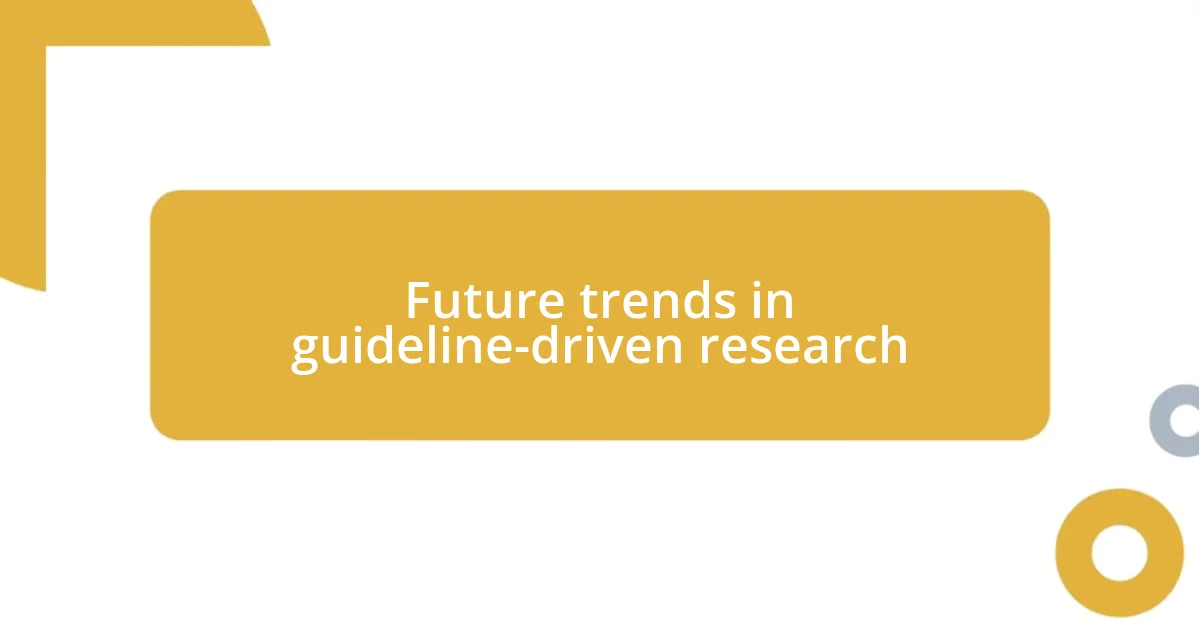
Future trends in guideline-driven research
One trend I’m noticing in guideline-driven research is the increasing use of technology for real-time adherence monitoring. During my last project, we integrated a tracking software that allowed us to log our compliance in a centralized system. This shift not only simplified the monitoring process but also fostered a sense of accountability within the team. Isn’t it incredible how technology can transform our approach to adherence, ensuring that we stay true to the guidelines?
I also foresee a greater emphasis on patient-centered guidelines in future research. For instance, I once attended a conference where we discussed the importance of involving patients in the guideline development process. Listening to their perspectives opened my eyes to the nuances that we often overlook. How might our research change if we truly integrated patients’ voices? It’s an exciting prospect that could lead to more relevant and impactful outcomes.
Lastly, I believe we will see a push for standardized training programs across institutions. Reflecting on my experiences, I often encountered disparities in guideline understanding among colleagues from different backgrounds. A collaborative approach to training could bridge these gaps, creating a more unified research environment. After all, isn’t it empowering to think that well-trained teams can drive adherence not just by obligation but by genuine understanding? This could very well reshape our future in guideline-driven research.










